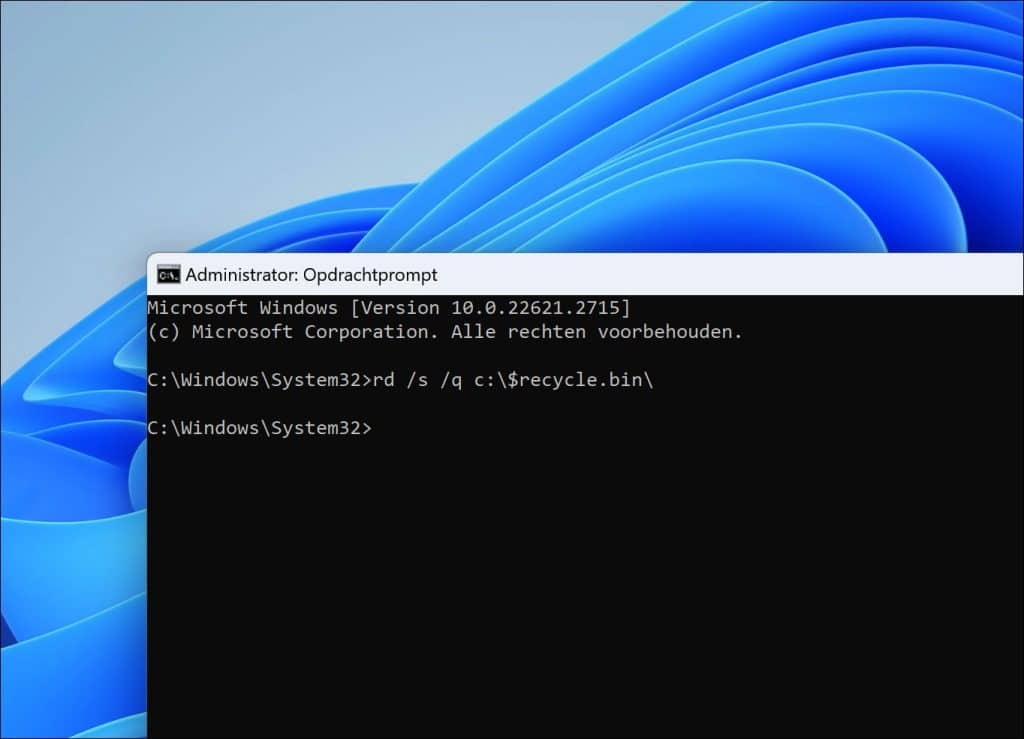We kennen allemaal het leegmaken van de prullenbak via het prullenbak pictogram op het bureaublad. Er is echter ook een alternatieve manier om de prullenbak te legen, namelijk via het Opdrachtprompt.
Zo kunt u dit bijvoorbeeld automatiseren. Als u gebruik maakt van scripts dan zou u het commando om de prullenbak te legen kunnen automatiseren door het in een script te verwerken. Ook als u alleen toegang heeft tot een Opdrachtprompt kunt u dit commando gebruiken om de prullenbak te legen.
Een andere reden is als Windows niet meer goed functioneert of als de Verkenner vastloopt wanneer u de prullenbak probeert te legen. In deze gids leg ik uit hoe het werkt.
Meld u dan aan voor onze nieuwsbrief.
Prullenbak Leegmaken via Opdrachtprompt
De prullenbak zoals we die kennen is als het ware gewoon een map op uw computer. Deze map bevat bestanden en submappen en bij het legen van de prullenbak wordt deze map geleegd. Het gaat hier om een verborgen map genaamd “$Recycle.Bin”. Deze map bevindt zich op iedere schijf. Dat betekent als u meerdere schijven heeft u de schijfletter in onderstaand commando moet aanpassen om de prullenbak op die schijf te legen.
Dit commando verwijdert alle bestanden in de opgegeven map permanent. Het is belangrijk om zeker te zijn dat u alle bestanden in de prullenbak echt wilt verwijderen.
Om te beginnen opent u een Opdrachtprompt als administrator. Hierna geeft u het volgende commando in:
rd /s /q c:\$recycle.bin\
Zoals aangegeven wijzigt u c: naar een andere schijf om daar de prullenbak te legen wanneer u een andere of meerdere schijven heeft. Hierbij een toelichting wat dit commando doet.

- rd: Dit staat voor ‘remove directory’ (verwijder map). Het is een commando dat wordt gebruikt om een map en alle bestanden en submappen erin te verwijderen.
- /s: Deze optie staat voor ‘subdirectories’ (submappen). Het zorgt ervoor dat naast de map zelf, ook alle submappen en bestanden in die map worden verwijderd. Zonder deze optie zou het ‘rd’-commando alleen lege mappen kunnen verwijderen.
- /q: Dit staat voor ‘quiet mode’ (stille modus). Normaal gesproken vraagt het ‘rd’-commando om bevestiging voordat het bestanden en mappen verwijdert. De /q-optie onderdrukt deze vragen om bevestiging, zodat het verwijderen automatisch gebeurt zonder interactie.
- C:$Recycle.Bin: Dit verwijst naar de locatie van de Recycle Bin op de C:-schijf. $Recycle.Bin is een systeemmap die de verwijderde bestanden bevat. De $ geeft aan dat het een verborgen systeemmap is.
Gebruik dit commando met voorzichtigheid en zorg ervoor dat u begrijpt wat het doet voordat u het uitvoert. Het is ook raadzaam om back-ups van belangrijke gegevens te maken voordat u bovenstaande commando uitvoert.
Lees ook: Automatisch bestanden in Prullenbak verwijderen.
Ik hoop u hiermee geholpen te hebben. Bedankt voor het lezen!


Help mee
Mijn computertips zijn gratis en bedoeld om andere mensen te helpen. Door deze pc-tip te delen op een website of social media, helpt u mij meer mensen te bereiken.Overzicht met computertips
Bekijk ook mijn uitgebreide overzicht met praktische computertips, overzichtelijk gesorteerd per categorie.Computerhulp nodig?
Loopt u vast met uw pc, laptop of software? Stel uw vraag op ons computerforum en krijg gratis computerhulp van ervaren leden en experts.